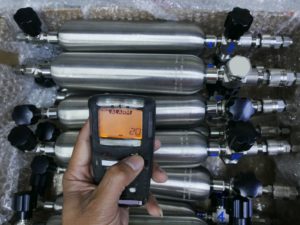The Hazards of Hydrogen Sulfide

What is Hydrogen Sulfide?
Hydrogen sulfide (H2S), a chemical compound, is a colorless gas that has an overpowering odor likened to rotten eggs. Hydrogen sulfide is naturally produced when organic materials undergo a microbial breakdown and oxygen is absent. Hydrogen sulfide is heavier than air and is therefore found in low-lying areas. H2S is poisonous and considered highly toxic to human health. This is because H2S akin to carbon monoxide (CO) prevents cellular respiration. Hydrogen sulfide is also flammable, highly reactive, and is a corrosive agent.
 Where is Hydrogen Sulfide Found?
Where is Hydrogen Sulfide Found?
As a naturally produced gas from decaying organic matter, hydrogen sulfide can be released from garbage landfills, sewage sludge, swamps, liquid manure, hot sulfur springs, well water, and oil and gas wells. H2S also can be found in natural and volcanic gases. Hydrogen sulfide is commonly used and produced by several industries including oil and gas, mining, pulp and paper processing, and rayon manufacturing. Processes such as petrochemical refining, oil and gas drilling, wastewater treatment, sewerage operations, and hot asphalt paving can release hydrogen sulfide as a by-product. Hence, hydrogen sulfide may be found in underground tanks, sewers, manure storage tanks, manure pits, tunnels, wells, and confined spaces; around refining operations and livestock; and while processing pulp, paper, and textiles.
When Does Hydrogen Sulfide Gas Become Dangerous to Human Health?
Hydrogen sulfide is present in the atmosphere at low levels, it is also released as exhaust from cars. Such low levels of exposure to H2S is considered a part of our daily lives. However, care must be taken when exposure occurs in occupational settings. This is because the length of exposure, the quantity of H2S gas exposed to, the route of exposure, and an individual’s preexisting medical conditions together with age, dietary habits, and other personal factors can impact the toxicity of exposure to hydrogen sulfide. As a result, both OSHA and NIOSH provide guidance to protect workers from H2S exposure in occupational settings. Hydrogen sulfide exposure at or above 100 ppm (parts per million) is considered immediately dangerous to life and health (IDLH) as stated by NIOSH, while OSHA provides worker exposure limits using an enforceable permissible exposure limit (PEL) level for different industries and timeframes.
The table below gives guidance on worker exposure limits.
| Worker Exposure Limits |
| NIOSH REL (10-min. ceiling): 10 ppm |
| OSHA PELs: |
|---|
| General Industry Ceiling Limit: 20 ppm |
| General Industry Peak Limit: 50 ppm (up to 10 minutes if no other exposure during shift) |
| Construction 8-hour Limit: 10 ppm |
| Shipyard 8-hour limit: 10 ppm |
| NIOSH IDLH: 100 ppm |
|
Table Source: OSHA. (n.d.). Hydrogen Sulfide - Hazards. Website. https://www.osha.gov/hydrogen-sulfide
What are the Routes of Hydrogen Sulfide Exposure?
There are several main routes of worker exposure to hydrogen sulfide.
Breathing (Inhalation)
The most likely and common route of exposure to H2S is breathing in the gas. Workers in occupations where hydrogen sulfide is produced as a by-product and working in windless or low-lying areas, in hot weather conditions, in confined spaces, or close to swamps are more likely to be exposed to higher doses of H2S in the atmosphere. Inhalation of the H2S gas can also occur due to accidental releases. While people can smell the rotten egg odor of H2S, continuous low-level exposure or sudden high concentrations of hydrogen sulfide results in the loss of the ability to smell the H2S gas, known as olfactory fatigue. Therefore, using smell to detect H2S in the air is not a reliable method.
Touching (Absorption through the Skin or Eye)
Touching is another method of exposure to hydrogen sulfide. Workers would be exposed if they touch other materials that contain H2S or have direct contact with liquid hydrogen sulfide. Workers exposed to H2S even in low concentrations may absorb the gas through the eyes.
Drinking (Ingestion)
As water can be contaminated with H2S, any worker working in an industry where hydrogen sulfide is produced or used has a possibility of being exposed through this route.
What are the Symptoms and Health Hazards Associated with Hydrogen Sulfide Exposure?
Employees who may be exposed to hydrogen sulfide must be aware that hydrogen sulfide has an adverse impact on the human respiratory system, central nervous system, cardiovascular system, renal system, and the skin and eyes. The below symptoms and health hazards associated with H2S exposure impact the above-mentioned human biological systems. The severity of the symptoms and the associated health problems are dependent on the length and dose of exposure among other factors. Hence, undergoing regular medical checkups is advised if working in occupations with exposure to hydrogen sulfide.
| 1. Skin irritation | 8. Chronic cough | 15. Irritability |
| 2. Eye irritation | 9. Fluid in the lungs | 16. Headache |
| 3. Throat irritation | 10. Low blood pressure | 17. Loss of appetite |
| 4. Shortness of breath | 11. Weight loss | 18. Memory problems |
| 5. Eye-membrane inflammation | 12. Nausea | 19. Loss of consciousness leading to falls and other injuries |
| 6. Dermatitis | 13. Tiredness | |
| 7. Frostbite | 14. Dizziness |
 What can Employers do to Safeguard Worker Safety and Health?
What can Employers do to Safeguard Worker Safety and Health?
Following OSHA and NIOSH recommendations will enable employers to safeguard workers exposed to hydrogen sulfide. Employers must employ the Hierarchy of Controls to safeguard workers’ health and apply relevant engineering controls, administrative controls, and work practice controls within the workplace. Furthermore, as required, workers must be provided with personal protective equipment (PPE) such as a full facepiece pressure-demand self-contained breathing apparatus (SCBA) and personal H2S detectors. Regularly undertaking air monitoring in areas with possible exposure to hydrogen sulfide and installing hydrogen sulfide detectors in case of a gas leak are good practices to implement at the worksite. In addition, employers must ensure that employees exposed to or with the possibility of exposure to hydrogen sulfide be given adequate training and knowledge to:
- Understand the characteristics of hydrogen sulfide;
- Identify sources that produce and release the H2S gas;
- Explain the safety and health hazards of H2S exposure;
- Distinguish the different occupational exposure limits of H2S given by various organizations;
- Understand the symptoms of H2S exposure;
- Understand the need for medical surveillance when working in occupations with the possibility of H2S exposure;
- Understand the Hierarchy of Controls and how it is applicable; and
- Enact first-aid procedures when exposed to hydrogen sulfide.
Employers can provide this training using a combination of online and classroom training as well as on-site and on-the-job training.
We provide a comprehensive training course for Hydrogen Sulfide Awareness. Employees working in occupations and industries with possible exposure to H2S can enroll in our OSHA Hydrogen Sulfide Awareness online training today!
References:
- Delaware Health and Social Services – Division of Public Health. (2013, September, Revised). Frequently Asked Questions: Hydrogen Sulfide [PDF]. Website. https://dhss.delaware.gov/dhss/dph/files/hydsulffaq.pdf
- OSHA. (2005, October). OSHA Fact Sheet - Hydrogen Sulfide (H2S) [PDF]. Website. https://www.osha.gov/sites/default/files/publications/hydrogen_sulfide_fact.pdf
- OSHA. (n.d.). Hydrogen Sulfide - Hazards. Website https://www.osha.gov/hydrogen-sulfide
- OSHA. (n.d.). Hydrogen Sulfide – Overview. Website. https://www.osha.gov/hydrogen-sulfide

 EN |
EN |  ES
ES






























































































































